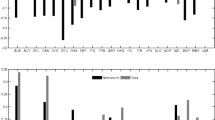Abstract
This paper investigates the effects of volatility scaling on factor portfolio performance and factor timing. We focus on the four equity factors analyzed by Carhart (1997) and find that volatility scaling may lead to higher diversification benefits for a long-horizon investor when equity factors are combined into a portfolio. Depending on the portfolio formation methodology, we also discover a substantial time-variation in portfolio performance. In addition, our results show that volatility scaling improves factor return predictability, but this does not necessarily translate into a profitable factor rotation strategy.





Similar content being viewed by others
Notes
In the following parts of the paper, we use interchangeably the terms volatility-managed factors and risk-adjusted factors.
As a robustness check, we also control for transaction costs and find that they do not affect the main findings of our paper. This further evidence is available upon request.
These funds are typically called style premia or alternative risk premia funds and in addition to equity factors may also trade these factors on other asset classes.
The returns associated with these portfolios are also available on Professor K. French website.
We use bold-face characters for vector and matrices while non-bold-face letters for scalars.
This result is consistent with Harvey et al. (2018) as they also show that volatility scaling improves downside measures of risk.
The lookback of one year is justified for example by the analysis of Moskowitz et al. (2012).
References
Arnott, C., N. Beck, V. Kalesnik, and J. West. 2016. How can ’smart beta’ go horribly wrong, Research Affiliates Notes, February 2016.
Asness, C., S. Chandra, A. Ilmanen, and R. Israel. 2017. Contrarian factor timing is deceptively difficult. The Journal of Portfolio Management 43 (5): 72–87.
Asness, C.S. 2016. Invited editorial comment. The Journal of Portfolio Management 42 (5): 1–6.
Barroso, P., and A. Dentzel. 2021. Do limits to arbitrage explain the benefits of volatility-managed portfolios? Journal of Financial Economics 140 (3): 744–767.
Barroso, P., and P. Santa-Clara. 2015. Momentum and its moments. Journal of Financial Economics 116 (1): 111–120.
Carhart, M. 1997. On persistence of mutual fund returns. Journal of Finance 52 (1): 57–82.
Cederburg, S., M.S. O’Doherty, F. Wang, and X.S. Yan. 2020. On the performance of volatility-managed portfolios. Journal of Financial Economics 138 (1): 95–117.
Dichtl, H., W. Drobetz, and H. Lohre. 2019. Optimal timing and tilting of equity factors. Financial Analysts Journal 75 (4): 84–102.
Fama, E., and K. French. 1993. Common risk factors in the returns on stocks and bonds. Journal of Financial Economics 65 (1): 3–56.
Fergis, K., K. Gallagher, P. Hodges, and K., H. 2019. Defensive factor timing. Journal of Portfolio Management 45 (3): 50–68.
Harvey, C., E. Hoyle, R. Korgaonkar, S. Rattry, M. Sargaison, and O. Van Hemert. 2018. The impact of volatility targeting. Journal of Portfolio Management 45 (1): 14–33.
Hocquard, A., S. Ng, and N. Papageorgion. 2013. A constant-volatility framework for managing tail risk. Journal of Portfolio Management 39 (2): 28–40.
Hoyle, E., and N. Shepard. 2018. Volatility scaling’s impact on the sharpe ratio, Working Paper, Harvard University.
Liu, F., X. Tang, and G. Zhou. 2019. Volatility-managed portfolio: Does it really work? Journal of Portfolio Management 46 (1): 38–51.
Maillard, S., T. Roncalli, and J. Teiletche. 2010. The properties of equally weighted risk contribution portfolios. Journal of Portfolio Management 36 (4): 60–70.
Markowitz, H. 1952. Portfolio selection. Journal of Finance 7 (1): 77–91.
Moreira, A., and T. Muir. 2017. Volatility-managed portfolios. Journal of Finance 72 (4): 1611–1644.
Moskowitz, T., Y. Ooi, and L. Pedersen. 2012. Time series momentum. Journal of Financial Economics 104 (2): 228–250.
Qiao, X., S. Yan, and B. Deng. 2020. Downside volatility-managed portfolios. Journal of Portfolio Management 46 (7): 13–29.
Sortino, F.A. 1994. Performance measurement in a downside risk framework. Journal of Investing 3 (3): 50–58.
Funding
The authors declare that they have not received any funding for the paper.
Author information
Authors and Affiliations
Corresponding author
Ethics declarations
Conflicts of interest
The authors declare that they have no conflict of interests.
Additional information
Publisher's Note
Springer Nature remains neutral with regard to jurisdictional claims in published maps and institutional affiliations.
The views expressed in this paper are exclusively the views of the authors and do not necessarily reflect the views of Bank of Italy or Pinechip Capital GmbH, their affiliates, or their employees. This paper was written when Federico Nucera was a researcher at LUISS University. It does not contain any investment advice. No responsibility is taken by the authors for any investment based on the results of this article. All remaining errors are our own.
Rights and permissions
Springer Nature or its licensor holds exclusive rights to this article under a publishing agreement with the author(s) or other rightsholder(s); author self-archiving of the accepted manuscript version of this article is solely governed by the terms of such publishing agreement and applicable law.
About this article
Cite this article
Nucera, F., Uhl, B. The impact of volatility scaling on factor portfolio performance and factor timing. J Asset Manag 23, 522–533 (2022). https://doi.org/10.1057/s41260-022-00279-9
Revised:
Accepted:
Published:
Issue Date:
DOI: https://doi.org/10.1057/s41260-022-00279-9



